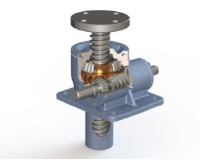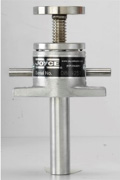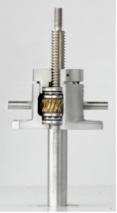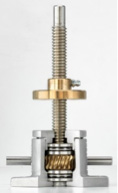 Screw jacks that are properly selected and maintained will reliably lift, position, support or hold industrial loads for years. Incorporating them into mechanized applications is a fairly simple matter once jack designs are understood.
Screw jacks that are properly selected and maintained will reliably lift, position, support or hold industrial loads for years. Incorporating them into mechanized applications is a fairly simple matter once jack designs are understood.
The basic components of machine screw jacks are lifting screw, gear set, and thrust bearing.
Jack Designs
Jacks come in three basic designs – Translating, Keyed for Non-Rotation, and Keyed for Traveling Nut (KFTN). They can be specified with a choice of four standard screw end conditions, T1-plain turned end, T2-load pad end, T3-threaded end, or T4-Male clevis end.
 Translating screw jacks are the most commonly specified jacks. With this design a driven worm acts on an internal worm gear, which in turn drives a lifting screw to extend or retract. All that is required for proper function is to restrain the rotation of the lifting screw and apply torque to the input shaft. This is often achieved through the use of guides or by attaching a common load across multiple jacks. It is also possible to attach the jack to a significant load which will overcome inherent rotational forces and allow the load to extend and retract. Most applications use this jack design.
Translating screw jacks are the most commonly specified jacks. With this design a driven worm acts on an internal worm gear, which in turn drives a lifting screw to extend or retract. All that is required for proper function is to restrain the rotation of the lifting screw and apply torque to the input shaft. This is often achieved through the use of guides or by attaching a common load across multiple jacks. It is also possible to attach the jack to a significant load which will overcome inherent rotational forces and allow the load to extend and retract. Most applications use this jack design.
 Keyed Jacks are keyed for non-rotation. With this variation of the translating screw jack a key, fixed to the jack housing and inserted into a keyway milled into the lifting screw, forces the lifting screw to translate without rotating. It is ideal for use in applications where a single jack must extend to meet and move a load to which it is not attached. Keyed jacks are commonly used in single jack applications where it would not otherwise be possible to restrain the rotation of the jack screw.
Keyed Jacks are keyed for non-rotation. With this variation of the translating screw jack a key, fixed to the jack housing and inserted into a keyway milled into the lifting screw, forces the lifting screw to translate without rotating. It is ideal for use in applications where a single jack must extend to meet and move a load to which it is not attached. Keyed jacks are commonly used in single jack applications where it would not otherwise be possible to restrain the rotation of the jack screw.
 Keyed-for-traveling-nut jacks (KFTN), feature a lifting screw keyed to the internal worm gear as a single unit, forcing the lifting screw to rotate, but not translate. A flanged traveling nut, attached to the load, is driven by the rotation of the lifting screw. Here again, it is important to restrain the rotation of the traveling nut by applying a significant load, or more commonly by guiding the load or attaching the load across multiple jacks. KFTN jacks mount flush and are a necessary choice when clearance space is not available for the protection tube.
Keyed-for-traveling-nut jacks (KFTN), feature a lifting screw keyed to the internal worm gear as a single unit, forcing the lifting screw to rotate, but not translate. A flanged traveling nut, attached to the load, is driven by the rotation of the lifting screw. Here again, it is important to restrain the rotation of the traveling nut by applying a significant load, or more commonly by guiding the load or attaching the load across multiple jacks. KFTN jacks mount flush and are a necessary choice when clearance space is not available for the protection tube.
For a complete listing of machine screw jack product options, ordering information and product specifications, visit the products page.
